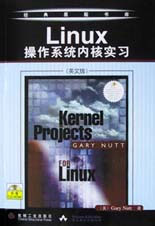-
>
决战行测5000题(言语理解与表达)
-
>
软件性能测试.分析与调优实践之路
-
>
第一行代码Android
-
>
深度学习
-
>
Unreal Engine 4蓝图完全学习教程
-
>
深入理解计算机系统-原书第3版
-
>
Word/Excel PPT 2013办公应用从入门到精通-(附赠1DVD.含语音视频教学+办公模板+PDF电子书)
Linux操作系统内核实习(英文版) 版权信息
- ISBN:7111100999
- 条形码:9787111100997 ; 978-7-111-10099-7
- 装帧:暂无
- 册数:暂无
- 重量:暂无
- 所属分类:>
Linux操作系统内核实习(英文版) 内容简介
The Manual includes an expansive introduction to Linux and working in the Linux environment. Twelve exercises provide hands-on learning by allowing students to work on programs that implement key theoretical operating system concepts The makeup of the manual allows students to learn concepts on a modern operating system Linux-while at the same time viewing the source code.
Linux操作系统内核实习(英文版) 目录
2. General Kernel R
2.1 Resource Abstraction
2.2 Sharing Resources
2.2.1 Managing Competition for Resources
2.2.2 Exclusive Use of a Resource
2.2.3 Managed Sharing
2.3 A Partition of OS Functions
3. Kernel Organization
3.1 Interrupts
3.2 Using Kernel Services
3.3 Serial Execution
3.4 Daemons
3.5 The Booting Procedure
3.5.1 The Boot Sector
3.5.2 Starting the Kernel
3.6 Logging In to the Machine
3.7 Control Flow in the Machine
4. Process and Resource Management
4.1 Running the Process Manager
4.1.1 System Call
4.1.2 Interrupts
4.2 Creating a New Task
4.3 The Scheduler
4.4 IPC and Synchronization
4.5 Protection Mechanism
5. Memory Management
5.1 Managing the Virtual Address Space
5.2 The Secondary Memory
5.3 Handling Missing Pages
5.4 Address Translation
6. Device Management
6.1 The Device Driver
6.2 Handling Interrupts
7. File Management
7.1 Mounting the File System
7.2 Opening a File
7.3 Reading and Writing the File
7.4 The Ext2 File System
8. Learning More about Linux
PART 2: EXERCISES
1 . Observing Linux Behavior
Introduction Problem Statement Part A
PartB PartC PartD
Attacking the Problem The /proc File System
Using argc and argv Organizing a Solution
Saving Your Work in a Shared Laboratory
2. Shell Program
Introduction Basic UNIX-Style Shell Operation
Putting a Process in the Background I/O Redirection
Shell Pipes Reading Multiple Input Steams
Problem Statement Part A Part B Part C
Attacking the Problem Organizing a Solution
Part A Parts B and C
3. Kernel Timers
Introduction How the Kernel Maintains the Time
Per Process Timers Problem Statement Part A
Part B Part C Attacking the Problem
Organization of the Linux Source Code Signals
Organizing a Solution
4. Kernel Modules
Introduction Module Organization
Module Installation and Removal Problem Statement
Attacking the Problem The read() Procedure
The End-of-File Condition Compiling a Module
Installing and Removing a Module
The Clock Resolution Question More Help
5. System Calls
Introduction The System Call Linkage
Defining the System Call Number
Generating a System Call Stub
Kernel Function Organization
Referencing User-Space Memory Locations
Problem Statement Part A Part B
Attacking the Problem The Kernel printk().Function
Organizing a Solution Rebuilding the Kernel
Leaving a Clean Environment
6. Shared Memory
Introduction The Shored Memory API
The Implementation Problem Statement
Attacking the Problem
7. Virtual Memory
Introduction The Virtual Address Space
Virtual Memory Areas Address Translation
The Page Fault Handler prirnary, Memory Allocotion
Problem Statement
Part A: Instrurnent the Virtual Memory Manager
Part B: Reporting the Performance
Attacking the Problem
8. synchronization Mechanisms
Introduction Blocking a Task Wait Queues
Using Wait Queues Problem Statement
part A Part B Attacking the Problem
9. The Schedulet
Introduction Process Management
Process States Scheduler Implementation
Fair-Share Scheduling Problem Statement
Part A Part B Attacking the Problem
Planning a Solution Comparing Scheduler Performance
l0. Device Drivers
Introduction Driver Organization
Loadable Kernel Module Drivers Example: A Disk Driver
Problem Statement Part A Part B
Attacking the Problem
11. File Systems
Introduction The Virtual File System Directories
Example: An MS-DOS File System Problem Statement
Part A Part B Part C
Attacking the Problem The MS-DOS Disk Format
The MS-DOS FAT Using the Floppy Disk API
Planning a Solution
12. File I/O
Introduction The Open and Close Operations
Read and Write Operations Block Allocation
Buffer Management Problem Statement
Part A Part B Part C Part D
Attacking the Problem The Open() Function
Caching the FAT A Solution Plan
Further Study
References
Index
Linux操作系统内核实习(英文版) 节选
You should keep a copy of all of your source code on a floppy disk so that you have a backup version of your code and can move among different lab machines for different work sessions.
- >
人文阅读与收藏·良友文学丛书:一天的工作
人文阅读与收藏·良友文学丛书:一天的工作
¥15.1¥45.8 - >
月亮与六便士
月亮与六便士
¥13.4¥42.0 - >
史学评论
史学评论
¥23.1¥42.0 - >
朝闻道
朝闻道
¥13.8¥23.8 - >
罗曼·罗兰读书随笔-精装
罗曼·罗兰读书随笔-精装
¥24.9¥58.0 - >
我从未如此眷恋人间
我从未如此眷恋人间
¥16.4¥49.8 - >
罗庸西南联大授课录
罗庸西南联大授课录
¥13.8¥32.0 - >
唐代进士录
唐代进士录
¥17.1¥39.8
-
4.23文创礼盒A款--“作家言我精神状态”
¥42.3¥206 -
4.23文创礼盒B款--“作家言我精神状态”
¥42.3¥206 -
一句顶一万句 (印签版)
¥40.4¥68 -
百年书评史散论
¥14.9¥38 -
1980年代:小说六记
¥52.8¥69 -
中图网经典初版本封面-“老人与海”冰箱贴
¥20¥40


















